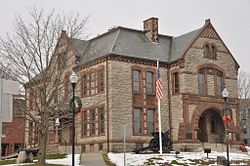
New York City Hall is the seat of New York City government, located at the center of City Hall Park in the Civic Center area of Lower Manhattan, between Broadway, Park Row, and Chambers Street. Constructed from 1803 to 1812, the building is the oldest city hall in the United States that still houses its original governmental functions. The building houses the office of the Mayor of New York City and the chambers of the New York City Council. While the Mayor's Office is in the building, the staff of thirteen municipal agencies under mayoral control are located in the nearby Manhattan Municipal Building, one of the largest government buildings in the world, with many others housed in various buildings in the immediate vicinity.

Harvard Yard, is the oldest and among the most prominent parts of the campus of Harvard University in Cambridge, Massachusetts. The yard has a historic center and modern crossroads and contains most of the freshman dormitories, Harvard's most important libraries, Memorial Church, several classroom and departmental buildings, and the offices of senior university officials, including the President of Harvard University.

The Cambridge, Massachusetts City Hall is the city hall for Cambridge, Massachusetts, located at 795 Massachusetts Avenue, and built in the Richardsonian Romanesque style. The building additionally serves as a centerpiece of the surrounding City Hall Historic District and adjacent Central Square Historic District.
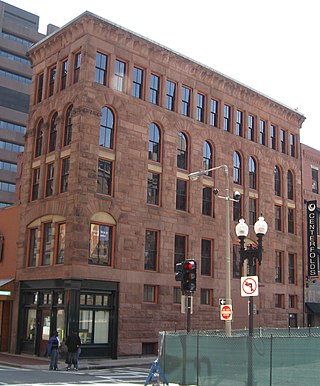
The Hayden Building is a historic building at 681-683 Washington Street in Boston, Massachusetts.

Winthrop Street Baptist Church is a historic Baptist church located at 39 Winthrop Street in Taunton, Massachusetts, USA. The Late Gothic Revival church was built in 1862 and was the second Baptist church built on the site. It was added to the National Register of Historic Places in 1984.

Milford Town Hall is the historic town hall at 52 Main Street in Milford, Massachusetts. The two story wood frame building was completed in 1854; in addition to its role in housing town offices for over a century, it is a distinctive local example of Italianate architecture, with pilasters articulating the building bays above a quoined basement level, a modillioned cornice, and alternating gabled and segmented-arch pediments above its windows. It is unusual among Milford's public buildings in not being built out of locally quarried granite.
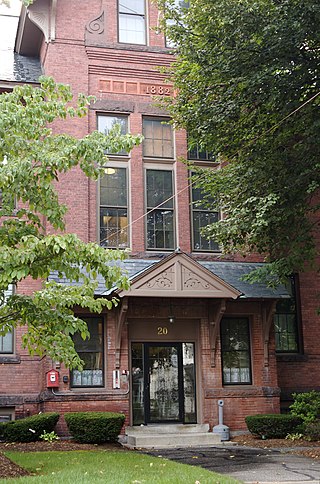
The Felton Street School is a historic school building built in 1882 located at 20 Felton Street in Hudson, Massachusetts, United States. The 2+1⁄2-story brick-and-stone structure served as the town's high school until 1957. Today it is a residential apartment building. The building's design and ornamentation is typical of Queen Anne and Stick style architecture. It is listed on the National Register of Historic Places.

The N. B. Borden School is a historic school building at 43 Morgan Street in Fall River, Massachusetts. It is a three-story red brick building with a mansard roof pierced by shed-roof dormers, and brownstone beltcourses above each level. It was built in 1867–68, during a period of growth in the city, and was used for many years as a vocational training school. It was listed on the National Register of Historic Places in 1983.
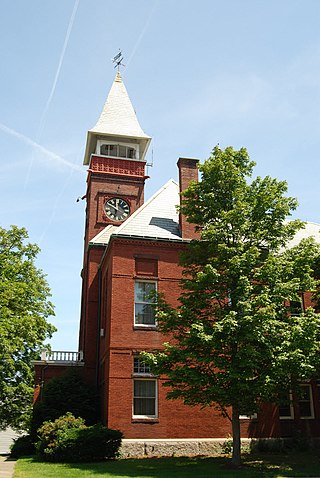
Walpole Town Hall is a historic town hall building at 972 Main Street in Walpole, Massachusetts, USA. The two-story brick building was designed by J. Williams Beal and completed in 1881. The building exhibits Classical Revival with Romanesque elements. Its most prominent feature is its 70-foot (21 m) square clock tower, topped by a pyramidal roof. The entrance is recessed at the base of the tower, under a large round-arch opening trimmed in brownstone.

Laurel Hall is a historic apartment house at 72—74 Patton Street in Springfield, Massachusetts, USA. Built in 1914, it is one of a small number of apartment houses built on the north side of the city's downtown area in the 1910s and 1920s. The building underwent a major rehabilitation and renovation in the 1980s. It was listed on the National Register of Historic Places in 1987.

The Gleason Building is a historic commercial building located at 349-351 Essex Street in Lawrence, Massachusetts.

The Old Public Library is a historic library building in Lawrence, Massachusetts. The Richardsonian Romanesque structure was built in 1892 to a design by George G. Adams, a leading architect of public buildings in New England. The building is predominantly brownstone, with terracotta trim bands, an irregular and asymmetric massing with a tower, and its entrance recessed in an archway. It served as Lawrence's public library until 1973 when a new library building was built.
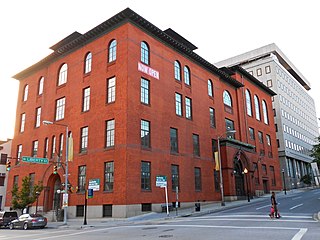
The Odd Fellows Hall in Baltimore, Maryland, United States, is a historic building that was the meeting place of the Independent Order of Odd Fellows fraternal organization, and is now an apartment building. It was built in 1891 and is a five bay structure featuring a central arched entrance with brownstone Romanesque columns and architraves. In the late 1970s, an adaptive reuse project retained most of its exterior architectural character while providing modern office space in the renovated interior.

The Fisher Hill Reservoir and Gatehouse are historic elements of the public water supply for the Greater Boston area.

St. Peter's Episcopal Church is a historic church complex at 61, 71, and 81 River Street in Milford, Connecticut. It includes a Gothic Revival church built out of Portland, Connecticut brownstone in 1850–51, and a rectory and parish hall, added on either side of the church in the mid-1890s. The church is a significant work of Frank Wills, a major proponent of the Gothic Revival. The church is also one of the few surviving 19th-century buildings in Milford's civic center. The complex was listed on the National Register of Historic Places in 1979.

George Milford Harding (1827–1910) was an American architect who practiced in nineteenth-century Massachusetts, New Hampshire, and Maine.

The Hall Memorial Library is the public library of Tilton and Northfield, New Hampshire. It is located at 18 Park Street in Northfield, in an 1887 Richardsonian Romanesque building. The building, one of the most architecturally distinguished in the region, was listed on the National Register of Historic Places in 1978.

Wilton Town Hall is located at 42 Main Street in downtown Wilton, New Hampshire. Built in 1886, the red brick building is a prominent local example of civic Queen Anne style architecture. In a common style of the day, it includes a theater space which was used for dramatic presentations, silent films, and vaudeville productions, before being converted to its present use as a movie theater. The building was listed on the National Register of Historic Places in 2009.

Upton State Forest is a publicly owned forest with recreational features primarily located in the town of Upton, Massachusetts, with smaller sections in the towns of Hopkinton and Westborough. The state forest encompasses nearly 2,800 acres (1,100 ha) of publicly accessible lands and includes the last remaining Civilian Conservation Corps (CCC) camp in Massachusetts, built in Rustic style. The CCC campground was listed on the National Register of Historic Places in 2014.

The United Bank Building is a historic commercial building at 19–21 Main Street in downtown New Milford, Connecticut. Designed by Wilson Potter and built 1902–04, it is a prominent local example of Classical Revival architecture, built to house two banks whose previous buildings had been destroyed in a fire. The building was listed on the National Register of Historic Places in 1982, and is a contributing element of the New Milford Center Historic District.
